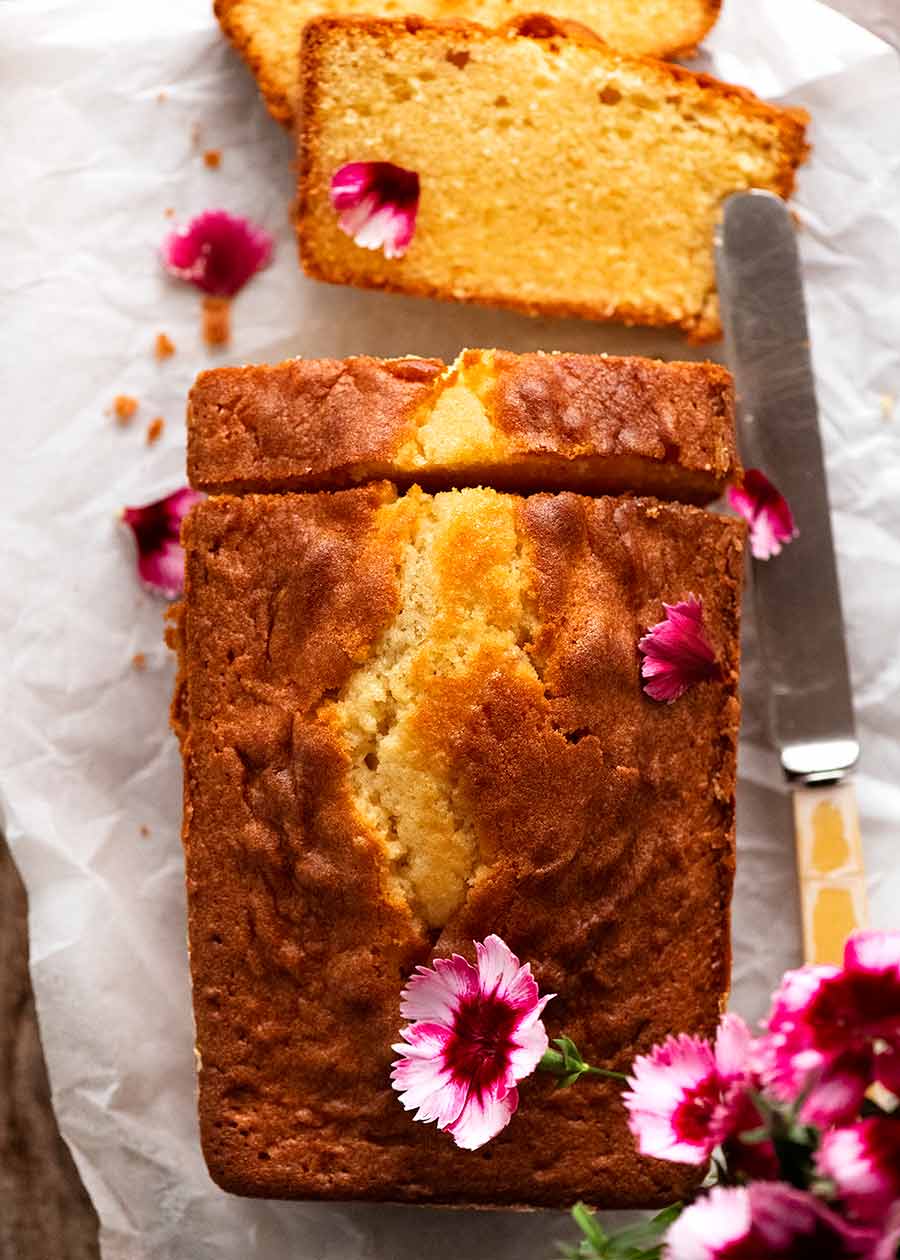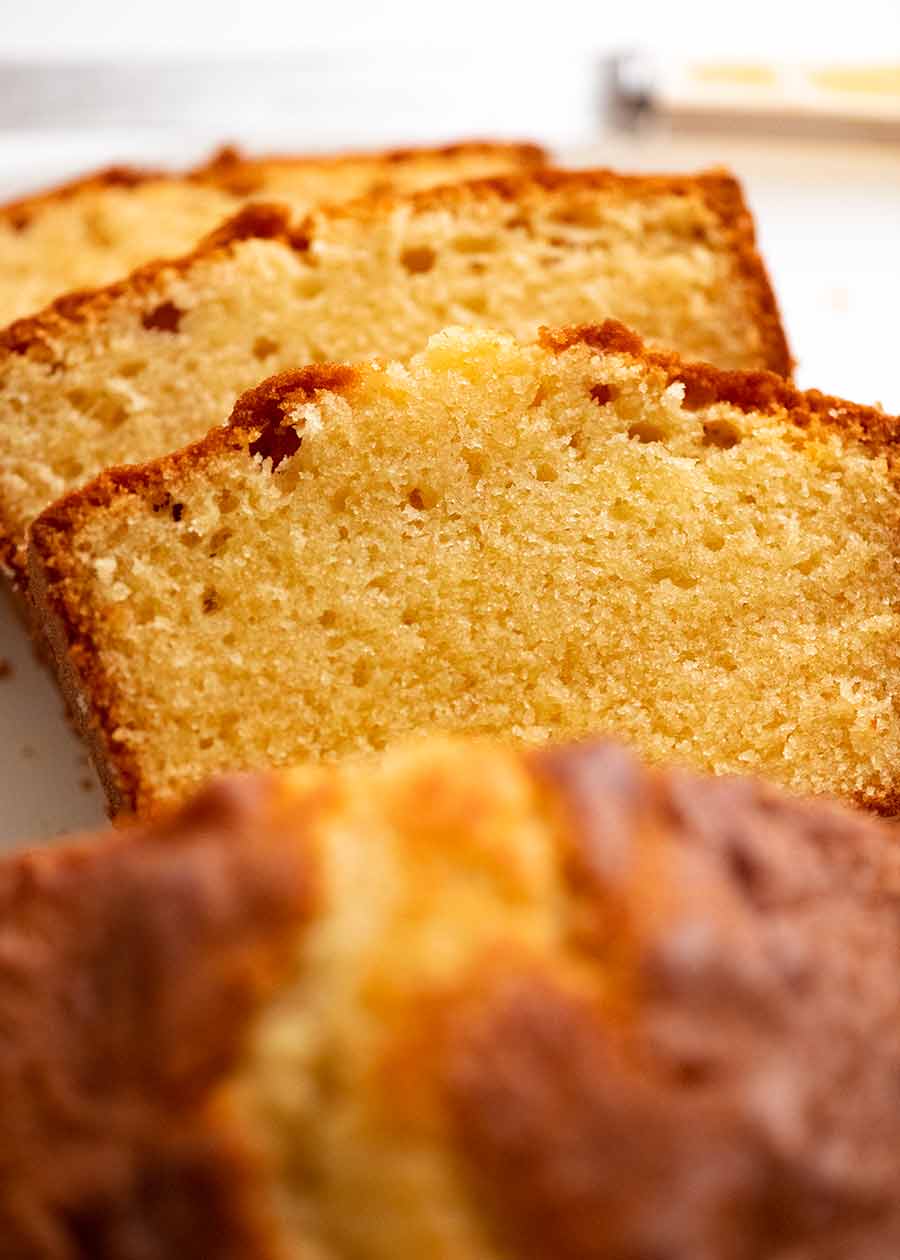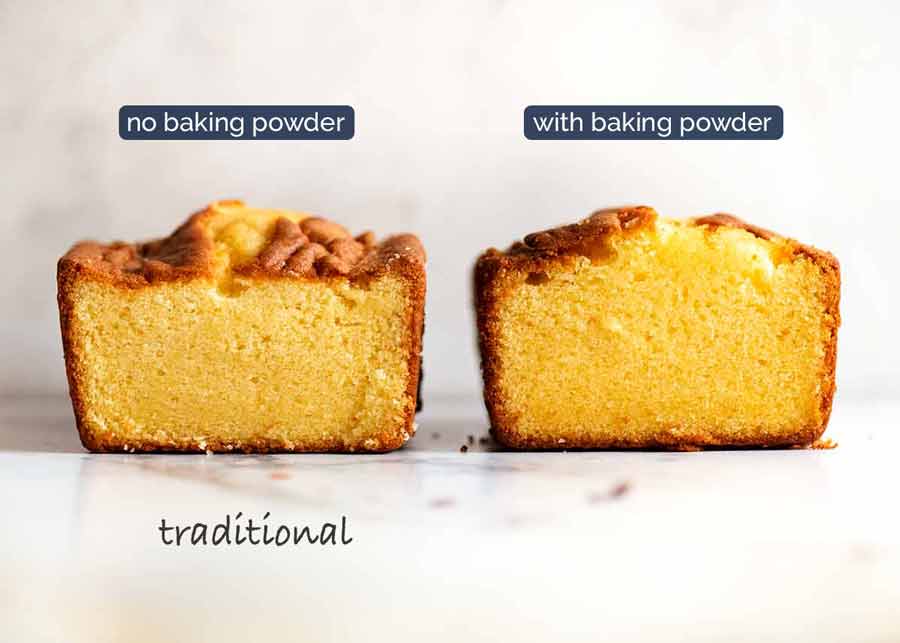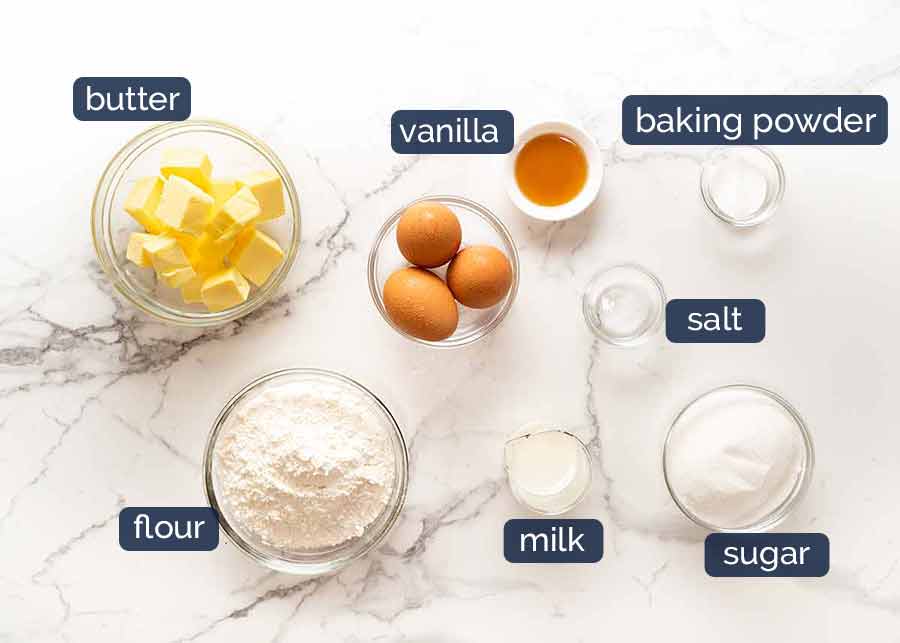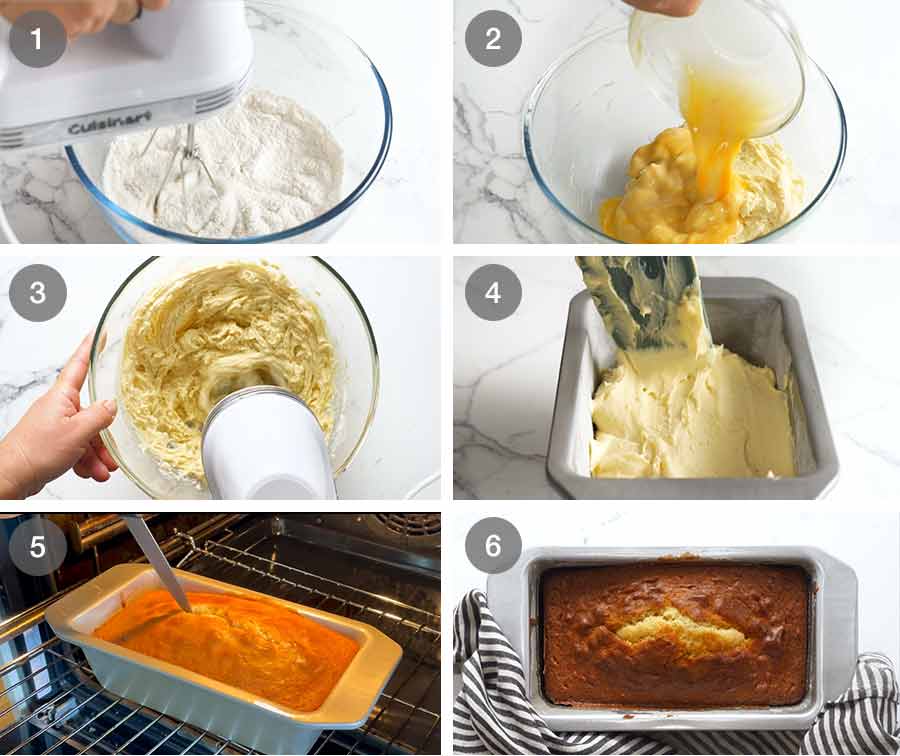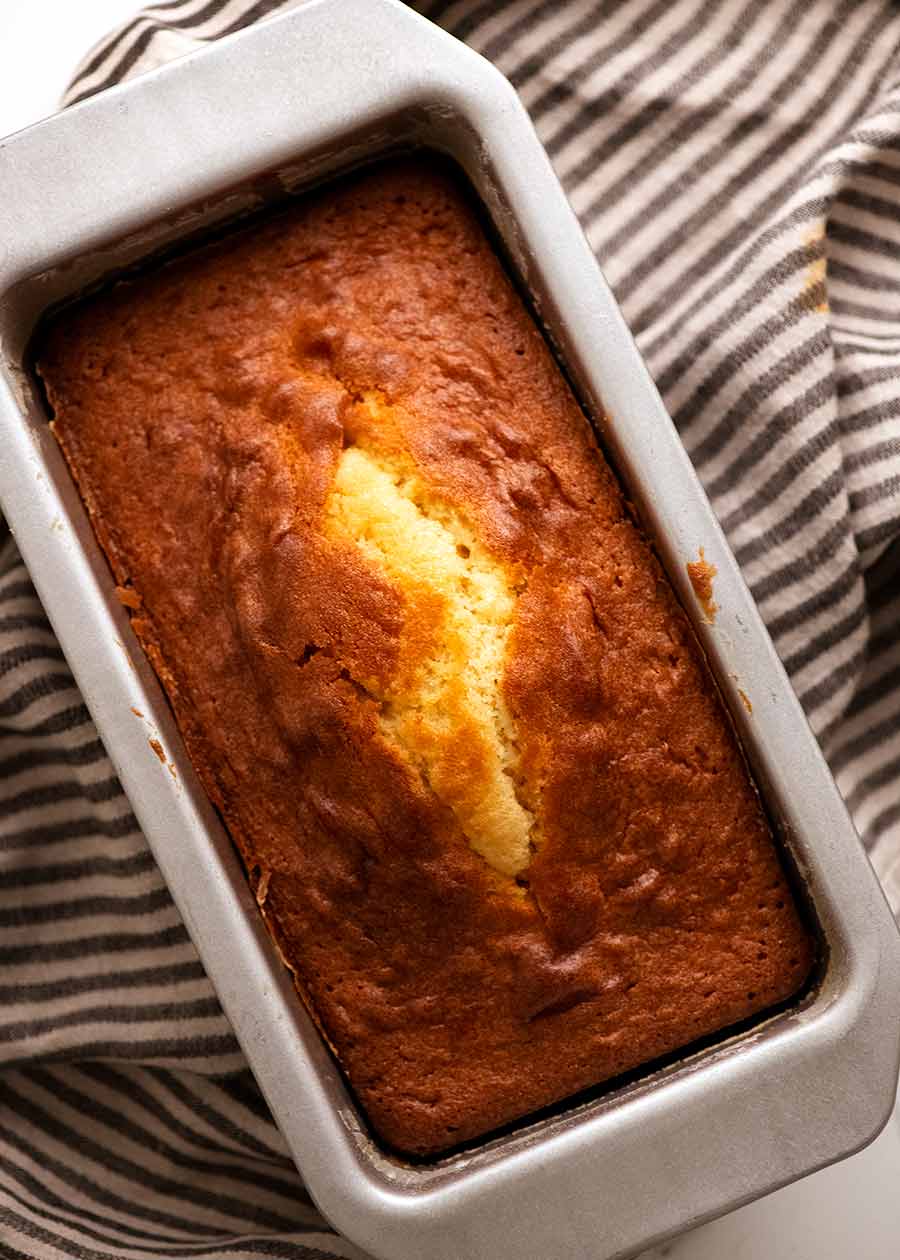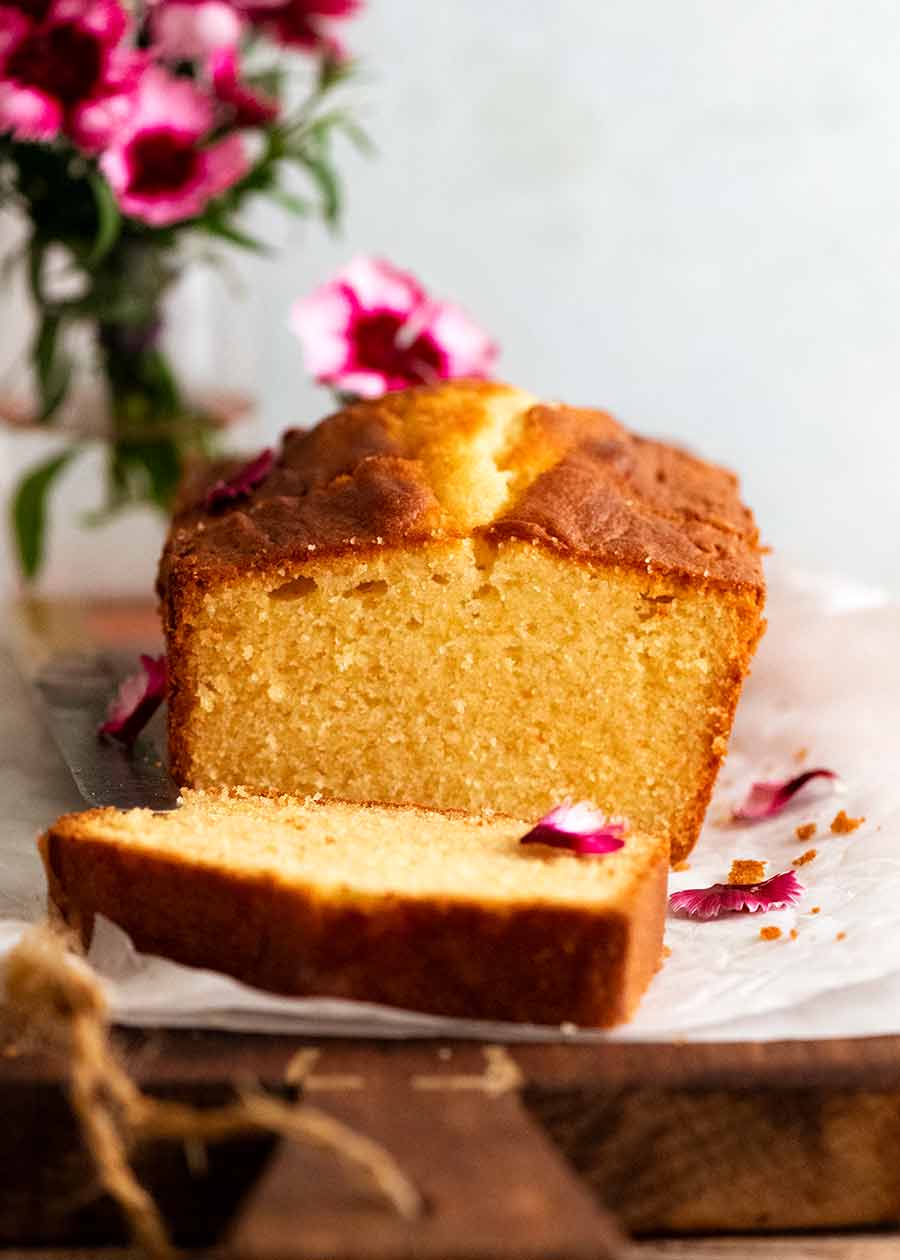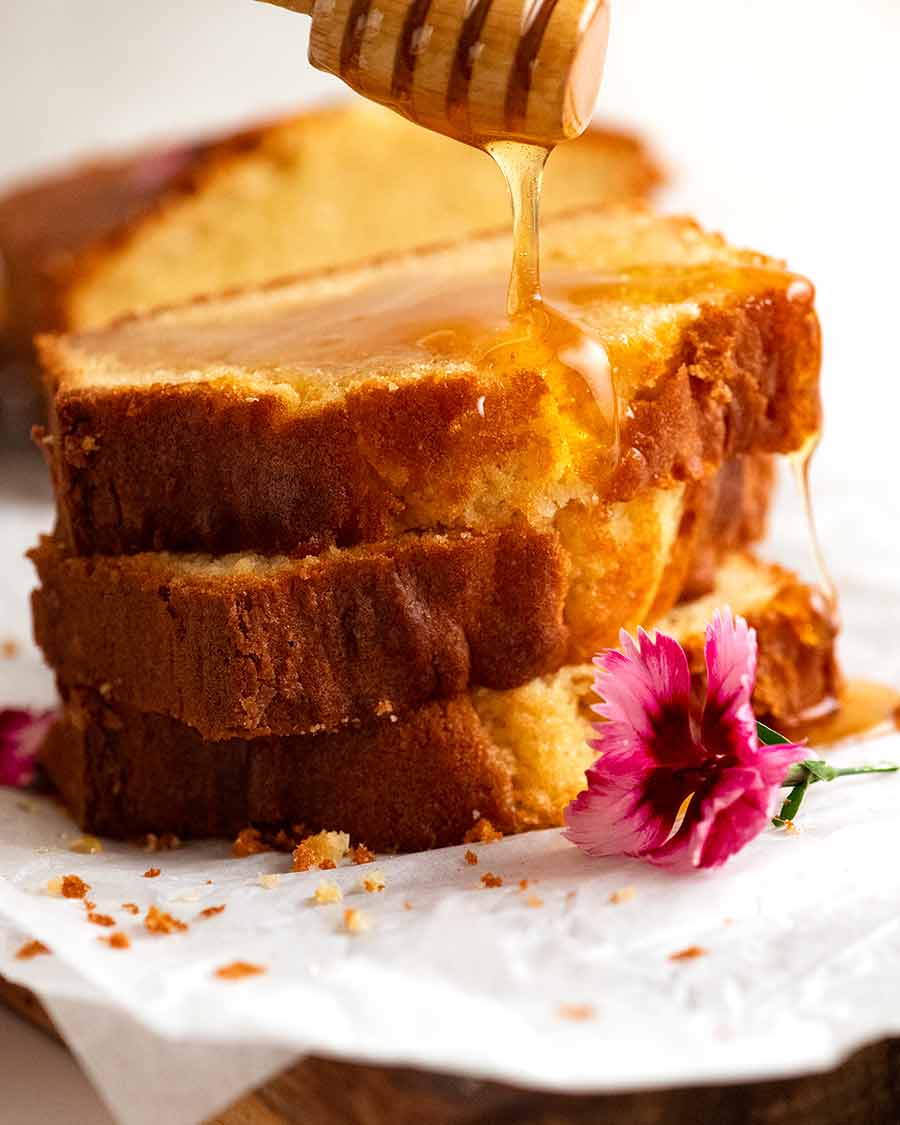Pound Cake
Pound Cake can spark spirited debates in the baking world. Some are adamant we should stay true to the traditional method that uses no baking powder in order to give it lift, resulting in quite a dense, heavy cake by modern tastes. Others insist on “improving” Pound Cakes by making the crumb much lighter and fluffier, giving rise to something (hah!) that barely resembles what a Pound Cake should be like. Me? I walk the line. I don’t want my Pound Cake to be light and fluffy like Vanilla Cake – if I did, I’d just make Vanilla Cake! Nor though do I want it made without any leavening agent at all, which I do find gives an overly heavy result. So this recipe uses just a bit of baking powder. Just 3/4 teaspoon, to be precise, in order to lighten up the crumb a touch whilst still bearing that signature denseness with all the vanilla buttery goodness we know and love about Pound Cake. A Pound Cake to please everyone, shall we say? 🙂 For interest, here’s the difference between a pound cake made with and without baking powder. You can see how much denser the traditional baking powder-less version is.
Pound Cake comparison – with and without baking powder
Ingredients in Pound Cake
Here’s what goes into pound cake. It might look like a lot of writing for such a simple cake. It’s intended to arm even novice bakers with enough information to build the confidence to make this! If you’re an experienced baker, feel free to skip straight to the recipe. Think of it as your great all-rounder. The cake you can pull out for afternoon tea, take into work for morning tea. Dress it up to serve for dessert, or grab a slice on the run!
Cake flour – Cake flour makes the pound cake rise slightly better, giving a nice little dome to the loaf. With plain / all-purpose flour, the pound cake doesn’t rise quite as much so the top surface is fairly flat. However I find the crumb is still soft and tender even so, meaning the difference is purely visual. If you’re ok with not having a traditional domed shape, then it’s fine to use plain flour.What exactly is cake flour? This is a flour that has lower protein than all-purpose / plain flour. This gives some cakes a softer crumb and helps it rise better. It’s not essential for all cakes. In fact, some cakes (like my Vanilla Cake) work better with plain / all-purpose flour.Butter (at room temperature) – When recipes call for butter at room temperature or softened butter, the butter needs to be firmer than you probably think. Ideally it is 18°C / 64°F. This is soft enough to whip until creamy, but still cool enough such that when you touch it, you don’t end up with a slick of grease on your finger.Butter that is too soft can lead to greasy cakes that do not rise as well as they should. In fact, this is one of the most common problems in cake making! A quick way to bring butter to room temperature: Cut fridge-cold butter into 1.5cm cubes (1/2″ thick slices if you have a US stick of butter). Scatter on plate. Microwave 2 cups of cold tap water for 4 minutes on high. Remove jug, quickly put plate in, close door. DO NOT turn microwave back on. The residual heat will soften the butter in 5 minutes.Baking powder – As noted above, traditional pound cakes do not have any leavening agent at all but I like to use a bit to lighten up the crumb a touch. If your baking powder has been sitting in the dark depths of your cupboard for a while, it’s best to check it’s still good – see here. Baking powder can be dead even if it’s not past the due date.Eggs at room temperature – The eggs need to be at room temperature and not fridge-cold, to ensure it incorporates properly into the batter and aerates properly when beaten. A quick way to warm up fridge-cold eggs: Place eggs in a large bowl, cover with warm tap water (just warm, not hot) and leave for 5 min. Wipe dry, then use per recipe. Egg size (“large eggs”): 50 – 55g / 2 oz per egg is the industry standard of sizes sold as “large eggs” in Australia and the US. If your eggs are significantly larger or smaller in size, just weigh different eggs and use 150-165g / 6 oz in total (including shell) or 135 – 150g / 5.4 oz in total excluding shell (useful if you need to use a partial egg to make up the total required weight. Crack eggs, beat whites and yolks together, THEN pour into a bowl to measure out what you need). Sugar – Superfine / caster sugar works better in this recipe because the grains are smaller than ordinary sugar, dissolving more easily into the batter. However if you only have ordinary white sugar, that will work just fine too.Salt – A pinch of salt in sweet baked goods is always a good thing. You can’t (shouldn’t!) be able to taste the saltiness, it’s there to help bring out flavour.Vanilla – As with all recipes that call for vanilla, the better the quality, the better the flavour. In descending order of quality: real vanilla beans, vanilla bean paste, vanilla extract, then bringing up the rear is vanilla essence (it’s artificial). For this recipe, I use vanilla extract. I usually reserve vanilla beans for more refined desserts, such as Creme Brûlée and Custard.
How to make Pound Cake
This recipe calls for specific mixing times, required to develop the structure of the cake’s crumb. If you shortcut the mixing times, you’ll find that the crumb is not as tender as it should be (as I found out firsthand!) What exactly is cake flour? This is a flour that has lower protein than all-purpose / plain flour. This gives some cakes a softer crumb and helps it rise better. It’s not essential for all cakes. In fact, some cakes (like my Vanilla Cake) work better with plain / all-purpose flour. Butter that is too soft can lead to greasy cakes that do not rise as well as they should. In fact, this is one of the most common problems in cake making! A quick way to bring butter to room temperature: Cut fridge-cold butter into 1.5cm cubes (1/2″ thick slices if you have a US stick of butter). Scatter on plate. Microwave 2 cups of cold tap water for 4 minutes on high. Remove jug, quickly put plate in, close door. DO NOT turn microwave back on. The residual heat will soften the butter in 5 minutes. A quick way to warm up fridge-cold eggs: Place eggs in a large bowl, cover with warm tap water (just warm, not hot) and leave for 5 min. Wipe dry, then use per recipe. Egg size (“large eggs”): 50 – 55g / 2 oz per egg is the industry standard of sizes sold as “large eggs” in Australia and the US. If your eggs are significantly larger or smaller in size, just weigh different eggs and use 150-165g / 6 oz in total (including shell) or 135 – 150g / 5.4 oz in total excluding shell (useful if you need to use a partial egg to make up the total required weight. Crack eggs, beat whites and yolks together, THEN pour into a bowl to measure out what you need). For this recipe, I use vanilla extract. I usually reserve vanilla beans for more refined desserts, such as Creme Brûlée and Custard. It can be made with either a handheld beater or stand mixer. I haven’t tried by hand – it can be done in theory, but the mixing times will depend on your stamina and strength!
How and what to serve Pound Cake
This is one of those cakes that’s extra-lovely served warm. If you do serve it warm, it’s wonderful even just eaten plain. To flour the pan, firstly grease the pan with butter. Add about 1/2 tbsp of flour and shake the pan so it coats the base and sides. Then shake out and discard the excess flour. The cake pan should be greased and ready to go before you start the batter because with most cakes, it’s important get the batter straight into the oven once made to make sure it rises as intended. Fill the loaf pan with the batter then smooth the surface. It doesn’t need to be perfectly smooth, the batter will even out in the oven. Bake for 30 minutes at 180°C/350°F (165°C fan), then do the split (if desired, see next step) then bake for a further 20 minutes. After 30 minutes in the oven, the surface of the pound cake should have a crack running down the middle. Open the oven door and ideally pull the shelf out without removing the pan from the oven as this will risk the cake collapsing. Working quickly, make a light cut with a small sharp knife along the split (about 15 cm / 6′′ long) to help the split to open up nicely. Work fast, do not leave oven open for long or the cake will collapse. Now close the oven door and bake for a further 20 minutes or until a skewer inserted into the centre comes out clean. Whether served warm or at room temperature, it’s still essentially a plain vanilla cake however. Which means it can always benefit from adding a dollop or smear of something! Here are some suggestions:
Whipped cream and fresh berries – very traditionalMascarpone, crème fraîche or thick yogurt instead of creamButter with honey, jam or a fruit compoteA sprinkle of crushed nuts (pistachio would look and taste especially fabulous) for texture, teamed with any of the above listed dolloping thingsIce cream or cream – Just think: warm Pound Cake and a scoop of ice cream, perhaps with a drizzle of chocolate sauce. Aaaahhhh! Be still my beating heart!A dusting of icing sugar / powdered sugar – great with any and all of the above.
Oh and don’t forget to message me when your Pound Cake is ready. I’ll pop right over for afternoon tea. Thanks! 😉 – Nagi x
Watch how to make it
Let them eat cake! 10 more classic cakes
Life of Dozer
The house I’m renting while my house is being renovated has a walk in robe!!! Dozer’s made himself at home….
